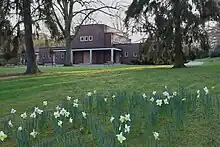Altona Main Cemetery
Altona Main Cemetery (German: Hauptfriedhof or Friedhof Altona) is located at Stadiongasse 5, Bahrenfeld, Altona, in north-western Hamburg, Germany and, with an area of 63 hectares, is the fourth largest burial ground in the city and surrounding area.[1] It has been a protected site since the revision of the Hamburg Monument Protection Law (Hamburger Denkmalschutzgesetz) in 2013.[2]



History
The main cemetery of Altona was planned from 1913 by Ferdinand Tutenberg, Director of Gardens of the then District of Altona. The new facility, designed as a central cemetery for the whole of Altona, was to replace the existing small church burial grounds and with its generous area of green to provide an appropriately contemporary element of town planning. Construction began in spring 1920; the first burial took place on 2 October 1923, even before the official opening on 1 November 1923. The address was given by the Mayor of Altona, Bernhard Schnackenburg, three months before his untimely death from typhus.[3]
Tutenberg's plan was based on the concept of an "architectonic landscape" which would make possible a dignified burial even for the less well-off inhabitants of the town. To explain his intentions Tutenberg wrote in 1928: "A visitor to the dead will not have the view of rows of graves stretching away into the distance but through the smaller space of the little garden... will have the opportunity for inner composure".[4] Thus a geometric and axial network of paths was laid out, the central axis of which was formed by the broad central avenue, now terminating in a monument honouring the fallen of World War II. To the west of this axis are alternating areas of park and woodland, and to the east the area for urn burials, laid out in concentric circles.
Most burials are marked by grave steles, whereby the desired homogeneity of appearance is attained. In the wooded section however there are also some elaborate burial walls or crosses. The site has a chapel and two nurseries for the cemetery gardener. The chapel was extended by Gustav Oelsner in 1926-27 by the addition of the rectangular arcade. A crematorium was originally planned, but was never built.
Up to 2012 more than 100,000 burials had taken place in the cemetery.[5]
The present
War graves
There are 1,856 war graves from World War II, mostly civilian casualties from the bombing of Altona, but also some graves of soldiers. The present arrangement dates from the end of the 1960s, when the dead whose graves had been scattered throughout the cemetery during the war were re-buried in one spot around a high cross; the soldiers' graves are directly next to it. The graves of the bombing victims are arranged in the shape of a cross. The gravestones are in the form of either standing crosses or flat stones. The soldiers' gravestones bear only an Iron Cross and the name of deceased, without any other decoration or even the dates of birth and death.
HSV cemetery
Since 2008[6][7] there has been in the north-east of the cemetery a special burial ground for supporters of the Hamburger SV (HSV): the Volksparkstadion lies directly over the road. For its construction inspiration was taken from the shape of a football stadium, with allusions to elements such as the stands, the goal and the field. Parts of the area have been laid with turf from the stadium ground itself.[8]
Graves of notable people
- Max Brauer (1887 - 1973), Mayor of Altona
- Ferdinand Tutenberg (1874 - 1956), planner of the cemetery
- Bernhard Schnackenburg (1867 - 1924), Mayor of Altona
- Ernst Budzinski (1888 - 1951), actor
- Adolf Jäger (1889 - 1944), footballer
- Herbert Tobias (1924 - 1982), photographer[6]
- Peter Rühmkorf (1929 - 2008), poet[6]
Future development
The cemetery has been run since its creation by the District of Altona. Integration into the central Hamburg cemetery administration is under discussion in the context of an administrative reform, but is regarded critically by the District of Altona.[9]
Photographs
 Grave of Max Brauer with a typical grave stele
Grave of Max Brauer with a typical grave stele HSV burial ground, with the HSV stadium in the background
HSV burial ground, with the HSV stadium in the background Central monument
Central monument Roma graves
Roma graves
Notes and references
- After Ohlsdorf Cemetery (391 ha), Öjendorf Cemetery (98.7 ha) and Neuer Friedhof Bergedorf (69 ha).
- Denkmalliste Altona (pdf)
- Helmut Stubbe da Luz: Schnackenburg, Bernhard in Hamburgische Biografie, Band 2, Christians, Hamburg 2003, pp. 374–375
- "Wer seine Toten besucht, soll nicht den Anblick weithin sich dehnender Gräberreihen haben, sondern soll durch den begrenzten Raum des Gärtchens [...] die Möglichkeit innerer Sammlung erlangen." Quoted in Barbara Leisner, Norbert Fischer: Der Friedhofsführer. Hamburg: Christians Verlag, 1994 ISBN 3-7672-1215-3
- Elbe Wochenblatt, 21 February 2012 Archived 2015-04-19 at the Wayback Machine. Viewed 24 September 2014
- Information on the HSV burial area from Bezirk Altona. Viewed on 10 September 2014
- Report in the Hamburg Magazin on the Altona Volkspark and the HSV burial ground Archived 2014-09-22 at the Wayback Machine. Viewed on 10 September 2014
- The fans' cemetery on the webpage of the HSV Archived 2015-04-10 at the Wayback Machine. Viewed 24 September 2014
- Elbe Wochenblatt, 22 October 2013 Archived 2015-04-19 at the Wayback Machine. Viewed 24 September 2014
Literature
- Barbara Leisner; Norbert Fischer (1994), Der Friedhofsführer (in German), Hamburg: Christians Verlag, pp. 90–93, ISBN 3-7672-1215-3
- Bezirksamt Altona (ed.). "Hauptfriedhof Altona - Ihr Wegweiser" (PDF) (in German). Retrieved 2014-09-10.
- Bezirksamt Altona, ed. (2013), Zur Historie des Hauptfriedhofs Altona (in German), Hamburg
{{citation}}: CS1 maint: location missing publisher (link)
External links
- Website of Altona Cemetery (in German)
- List of the Cultural Monuments of the City of Hamburg (in German)
- Picture of the war graves on the website of the Volksbund Deutsche Kriegsgräberfürsorge (in German)